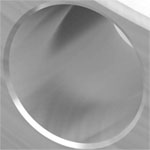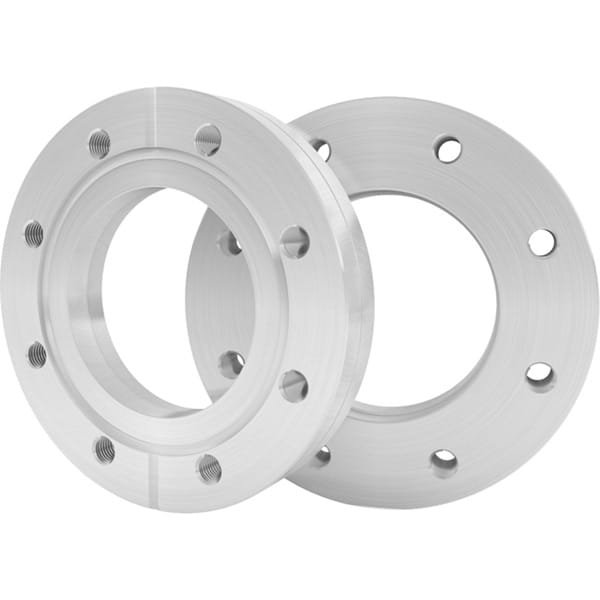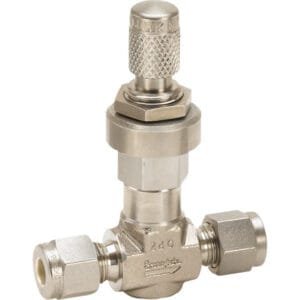Overview of ConFlat Flanges
The CF (ConFlat) flange is the standard choice for high vacuum (HV) and ultra-high vacuum (UHV) applications. This flange system supports a diverse range of gauges, instruments, accessories, and feedthroughs, making it highly versatile in vacuum technology.
Blank (Blind) Flanges
A blank or blind flange serves as a solid, disc-shaped fitting designed to be used within vacuum systems. It can be machined to create customized fittings or to effectively seal off unused tubing sections or ports on a vacuum chamber.
Seal Mechanism
The sealing mechanism of the CF flange employs a knife-edge machined just below the flange’s flat surface. When the bolts of a flange pair are tightened, these knife-edges cut into a soft metal gasket, creating annular grooves on either side. This process allows the extruded metal to fill in any machining marks and surface imperfections, resulting in a reliable, leak-tight seal. The CF seal can operate under pressures ranging from 760 torr (103 mbar) down to less than 1 x 10^-13 Torr (approximately 1.3 x 10^-13 mbar), and it functions effectively across a temperature range of -196°C to 450°C, depending on the materials used.
In North America, flange sizes are typically indicated by their outside diameter (O.D.), while in Europe and much of Asia, they are often referenced by the nominal internal diameter (I.D.) of the largest tube that can be welded to a bored flange.
Types of ConFlat Flanges
ConFlat flanges are available in four main configurations:
- Fixed Flange: This is a one-piece design with a fixed bolt-hole orientation relative to the fitting, ensuring stability during installation.
- Rotatable Flange: Comprising two components—a welded inner ring and an outer bolt ring—this design allows the bolt ring to rotate around the inner weld ring for optimal alignment.
Both fixed and rotatable flanges can be customized to include either through (clearance) holes or tapped holes, providing flexibility for various applications.
Through (Clearance) Holes

Are through-holes that allow adequate clearance for bolts to go through both flanges and secured by nuts or plate nuts.
Tapped Holes

Are imperial or metric threaded holes machined through the flange. This allows a clearance-hole flange to be connected without the need for nuts or plate nuts. Be aware of a components bolt hole orientation when selecting tapped flanges.
Ordering Table
Rotatable Tapped-Bored 304L SS Standard ConFlat® (CF) UHV Flanges
| Flange Size/OD | Note | Part Number |
| DN16CF (1.33" OD) | — | F0133X025RT |
| DN16CF (1.33" OD) | — | F0133X037RT |
| DN16CF (1.33" OD) | — | F0133X050RT |
| DN16CF (1.33" OD) | 1 | F0133X075RM |
| DN16CF (1.33" OD) | — | F0133X075RMW |
| DN16CF (1.33" OD) | 1 | F0133X075RT |
| DN16CF (1.33" OD) | — | F0133X075RTW |
| DN25CF (2.13" OD) | — | F0212X025RT |
| DN25CF (2.13" OD) | — | F0212X050RT |
| DN25CF (2.13" OD) | — | F0212X075RT |
| DN25CF (2.13" OD) | — | F0212X100RT |
| DN35CF-DN40CF (2.75" OD) | — | F0275X025RT |
| DN35CF-DN40CF (2.75" OD) | — | F0275X050RT |
| DN35CF-DN40CF (2.75" OD) | — | F0275X075RT |
| DN35CF-DN40CF (2.75" OD) | — | F0275X100RT |
| DN35CF-DN40CF (2.75" OD) | — | F0275X125RT |
| DN35CF-DN40CF (2.75" OD) | — | F0275X150RM |
| DN35CF-DN40CF (2.75" OD) | — | F0275X150RT |
| DN35CF-DN40CF (2.75" OD) | 2 | F0275X162RM |
| DN35CF-DN40CF (2.75" OD) | — | F0275X162RT |
| DN35CF-DN40CF (2.75" OD) | 2 | F0275X175RM |
| DN35CF-DN40CF (2.75" OD) | — | F0275X175RT |
| DN50CF (3.38" OD) | — | F0337X150RT |
| DN50CF (3.38" OD) | — | F0337X200RT |
| DN63CF (4.50" OD) | — | F0450X150RT |
| DN63CF (4.50" OD) | — | F0450X200RT |
| DN63CF (4.50" OD) | — | F0450X250RM |
| DN63CF (4.50" OD) | — | F0450X250RT |
| DN63CF (4.50" OD) | — | F0450X275RM |
| DN63CF (4.50" OD) | — | F0450X275RT |
| DN75CF (4.63" OD) | — | F0462X250RT |
| DN75CF (4.63" OD) | — | F0462X300RT |
| DN100CF (6.00" OD) | — | F0600X400RM |
| DN100CF (6.00" OD) | — | F0600X400RT |
| DN100CF (6.00" OD) | — | F0600X412RM |
| DN125CF (6.75" OD) | — | F0675X400RT |
| DN125CF (6.75" OD) | — | F0675X500RT |
| DN160CF (8.00" OD) | — | F0800X600RM |
| DN160CF (8.00" OD) | — | F0800X600RT |
| DN160CF (8.00" OD) | — | F0800X608RM |
| DN200CF (10.00" OD) | — | F1000X800RM |
| DN200CF (10.00" OD) | — | F1000X800RT |
| DN200CF (10.00" OD) | — | F1000X813RM |
| DN250CF (12.00" OD) | — | F1200X1000RM |
| DN250CF (12.00" OD) | — | F1200X1000RT |
| DN275CF (13.25" OD) | — | F1325X1000RT |
| DN275CF (13.25" OD) | — | F1325X1075RT |
| DN295CF (14.00" OD) | — | F1400X1200RT |
| DN350CF (16.50" OD) | — | F1650X1400RT |
| Flange Size/OD | Note | Part Number |





Reviews
There are no reviews yet.